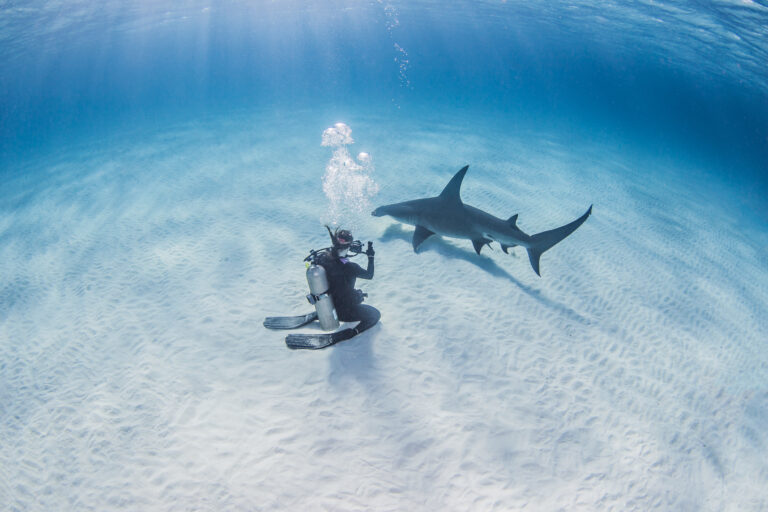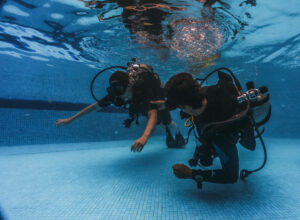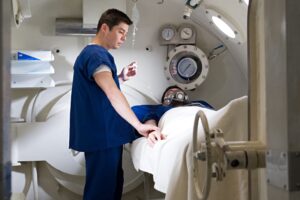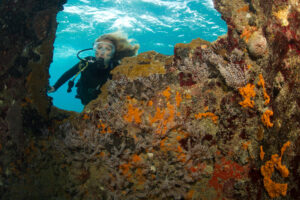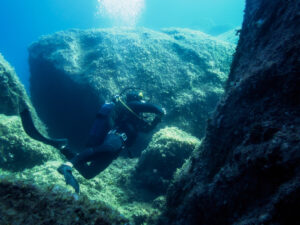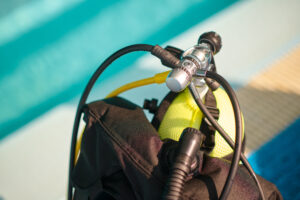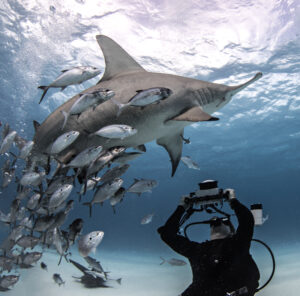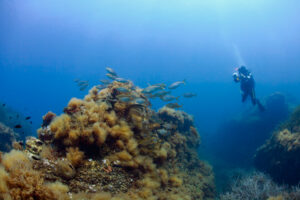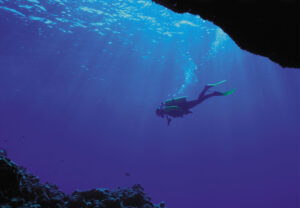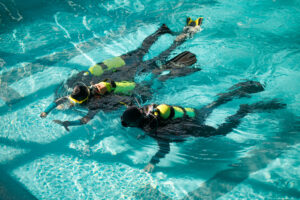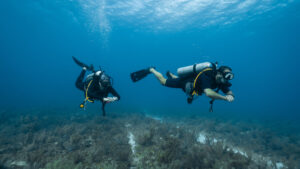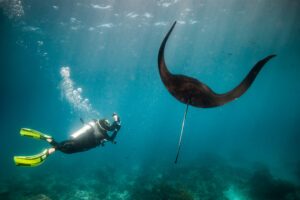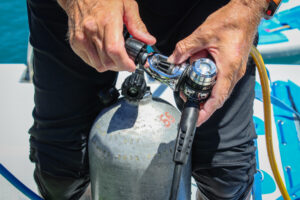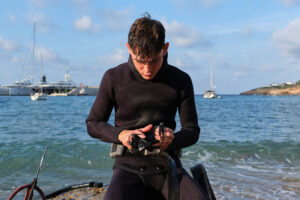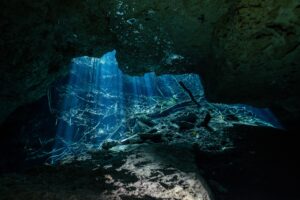What is Nitrogen Narcosis?
Nitrogen narcosis, often referred to as “raptures of the deep,” is a condition that affects scuba divers at significant depths. This phenomenon is induced by the increased partial pressure of nitrogen in the body as divers descend, leading to a narcotic effect on the central nervous system. Recognized by divers and scientists alike, nitrogen narcosis can impair judgment, motor coordination, and overall cognitive function, making it a critical issue in deep-sea diving.
Historical Background
The understanding of nitrogen narcosis dates back to the early days of deep-sea exploration. In the 19th century, divers and scientists began to notice peculiar changes in behavior and cognition at certain depths. One of the earliest documented cases was by Dr. Junod in 1834, who noted that compressed air affected the mental state of workers in caissons. However, it was not until the early 20th century that the condition was formally studied and understood.
Key figures in the study of nitrogen narcosis include John Scott Haldane and Paul Bert. Haldane’s pioneering work on decompression sickness also touched upon the effects of nitrogen under pressure, while Bert’s experiments with compressed air provided crucial insights into how gases behave under different conditions. Their contributions laid the groundwork for modern dive medicine and the safety protocols that are in place today.
As diving technology advanced, so did the understanding of nitrogen narcosis. The development of self-contained underwater breathing apparatus (SCUBA) in the mid-20th century allowed for deeper and longer dives, increasing the necessity for comprehensive knowledge about the condition. This evolution of understanding has been critical in developing strategies to mitigate the risks associated with nitrogen narcosis.
Physiological Mechanism
The physiological mechanism behind nitrogen narcosis is rooted in the behavior of gases under pressure. As a diver descends, the ambient pressure increases, leading to a higher partial pressure of nitrogen in the breathing gas. According to Henry’s Law, the amount of gas dissolved in a liquid is proportional to its partial pressure. Thus, at greater depths, more nitrogen is absorbed into the body’s tissues and bloodstream.
Nitrogen is an inert gas, meaning it does not undergo significant metabolic changes in the body. However, at elevated pressures, it can exert narcotic effects on the central nervous system. This is similar to the effect of anesthetic gases used in medical settings. The increased nitrogen interferes with neural transmission, leading to symptoms such as euphoria, impaired judgment, and decreased motor coordination.
The comparison to alcohol intoxication is often made because the symptoms of nitrogen narcosis are quite similar. Divers may feel a sense of lightheadedness, slowed reaction times, and reduced cognitive function. The severity of these symptoms can vary based on the depth, duration of exposure, and individual susceptibility. Understanding these physiological changes is crucial for safe diving practices.
Symptoms and Effects
Symptoms of nitrogen narcosis can manifest in various forms, depending on the depth and individual diver. Common symptoms include a sense of euphoria or overconfidence, which can be particularly dangerous as it may lead to risky behavior. Divers might also experience impaired judgment, making it difficult to assess situations accurately or respond to emergencies.
Motor coordination is often affected, leading to clumsiness or difficulty in executing precise movements. This can pose significant risks, especially when handling equipment or navigating underwater environments. Visual disturbances, such as blurred vision or tunnel vision, are also reported by some divers.
The severity of nitrogen narcosis can range from mild to extreme. In mild cases, divers might only experience slight euphoria or slowed thinking. However, in severe instances, the narcosis can lead to hallucinations, confusion, and a complete inability to perform basic tasks. These extreme effects are particularly hazardous as they can result in life-threatening situations if the diver is unable to manage their buoyancy or communicate with their dive buddy.
Factors Influencing Nitrogen Narcosis
Several factors influence the onset and severity of nitrogen narcosis. Depth is the most significant factor, as increased pressure directly correlates with higher nitrogen absorption. Generally, symptoms begin to appear around 30 meters (98.4 feet), but can vary widely among individuals. Some divers might experience symptoms at shallower depths, while others may tolerate deeper dives with minimal effects.
Individual susceptibility plays a crucial role. Factors such as body composition, hydration levels, and overall fitness can impact how a diver responds to increased nitrogen. Additionally, factors like anxiety or stress can exacerbate symptoms, making it more likely for narcosis to occur.
The rate of descent is another important consideration. Rapid descents can increase the likelihood of experiencing nitrogen narcosis, as the body has less time to acclimate to the changing pressure. Similarly, the duration of exposure at depth influences the accumulation of nitrogen in the body. Longer dives allow more nitrogen to be absorbed, increasing the risk of narcosis.
Environmental factors, such as water temperature and visibility, can also impact the onset of symptoms. Cold water can exacerbate the effects of narcosis, while poor visibility can increase stress and disorientation. Understanding these factors helps divers plan their dives to minimize the risk of nitrogen narcosis.
Prevention and Mitigation
Preventing and mitigating nitrogen narcosis involves a combination of proper planning, equipment use, and diver training. One of the primary strategies is to limit the depth and duration of dives. Adhering to recommended dive tables and using dive computers can help divers manage their nitrogen exposure effectively.
Proper training and experience are crucial in recognizing and responding to the symptoms of nitrogen narcosis. Divers are taught to ascend to shallower depths if they begin to experience symptoms, as this reduces the partial pressure of nitrogen and alleviates the narcotic effects. Regular practice and familiarity with diving equipment can also help divers manage situations more effectively.
The use of mixed gases is another effective mitigation strategy. By replacing some of the nitrogen in the breathing gas with helium, divers can reduce the narcotic potential. This is the principle behind technical diving gases like Trimix, which are used for deep dives to minimize nitrogen narcosis. Helium is less soluble in body tissues and does not exert the same narcotic effects as nitrogen, making it a safer alternative for deep dives.
Ensuring proper hydration and avoiding alcohol or sedatives before a dive can also help mitigate the risk. Alcohol and sedatives can exacerbate the effects of nitrogen narcosis, making symptoms more severe. Maintaining good physical fitness and managing stress levels are additional ways to reduce individual susceptibility to nitrogen narcosis.
Treatment and Management
Immediate action is essential if nitrogen narcosis is suspected during a dive. The most effective treatment is to ascend to a shallower depth. Reducing the ambient pressure decreases the partial pressure of nitrogen, which helps alleviate the narcotic effects. Ascending just a few meters can significantly reduce symptoms.
Effective communication and the role of a dive buddy are crucial in managing nitrogen narcosis. Divers should be vigilant in monitoring each other for signs of impaired behavior. A dive buddy can assist in guiding an affected diver to a shallower depth and ensuring they remain safe during the ascent.
In severe cases, medical intervention may be necessary. Once on the surface, oxygen therapy can help accelerate the elimination of nitrogen from the body. If symptoms persist, professional medical evaluation is recommended. While nitrogen narcosis does not have long-term effects once the diver returns to normal pressure, ensuring safety during and after the dive is paramount.
Impact on Diving Practices
The impact of nitrogen narcosis on diving practices is profound. It has influenced the development of safety protocols and dive planning to ensure divers remain within safe limits. Understanding the risks associated with deeper dives has led to more conservative depth limits for recreational diving and the use of advanced techniques for technical diving.
The condition has also driven innovations in diving technology. The use of dive computers has become standard practice, allowing divers to monitor their depth, time, and nitrogen levels in real-time. This technology helps divers stay within safe limits and reduces the risk of nitrogen narcosis.
Nitrogen narcosis has contributed to the development of technical diving, where divers use mixed gases to extend their depth limits safely. Technical diving training includes extensive education on nitrogen narcosis, ensuring that divers are well-prepared to handle the challenges of deeper dives. These advancements have made diving safer and more accessible to a broader range of enthusiasts.
Misconceptions and Myths
Despite extensive research, several misconceptions and myths about nitrogen narcosis persist in the diving community. One common misconception is that nitrogen narcosis only affects inexperienced divers. While experience can help divers recognize and manage symptoms, individual susceptibility means that even seasoned divers can be affected.
Another myth is that nitrogen narcosis is entirely preventable. While mitigation strategies can reduce the risk, it is not possible to eliminate the potential for narcosis completely. Understanding this helps divers remain vigilant and prepared to respond to symptoms if they occur.
There is also a misconception that nitrogen narcosis has long-term effects on the brain. In reality, the effects are temporary and subside once the diver returns to normal pressure. However, the immediate risks during a dive are significant, making it essential to take appropriate precautions.
Addressing these misconceptions through education and training is crucial for diver safety. By providing accurate information, the diving community can ensure that all divers are well-informed and prepared to manage the risks associated with nitrogen narcosis.
Current Research and Developments
Current research on nitrogen narcosis focuses on understanding the precise mechanisms behind the condition and developing improved prevention and treatment strategies. Advances in diving medicine and technology continue to enhance our knowledge and capabilities.
Studies are investigating the role of genetic factors in individual susceptibility to nitrogen narcosis. Understanding genetic predispositions could lead to personalized diving recommendations and improved safety protocols. Additionally, research into the use of alternative breathing gases and mixtures aims to further reduce the risks associated with deep diving.
Developments in dive computer technology are also contributing to safer diving practices. Modern dive computers can provide real-time monitoring and advanced algorithms to predict and manage nitrogen levels more accurately. These advancements help divers stay within safe limits and respond quickly to any signs of nitrogen narcosis.
The ongoing collaboration between divers, researchers, and medical professionals is essential in advancing our understanding of nitrogen narcosis. By continuing to study and innovate, the diving community can enhance safety and ensure that divers can explore the depths with confidence.
Key Takeaways
Nitrogen narcosis is a significant concern in scuba diving, affecting divers’ cognitive and motor functions at depth. Understanding its physiological mechanisms, symptoms, and influencing factors is crucial for safe diving practices. Effective prevention, mitigation, and treatment strategies, along with ongoing research, continue to improve diver safety and enhance the diving experience.

